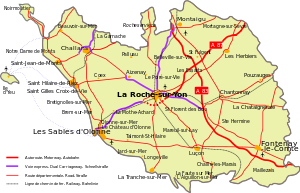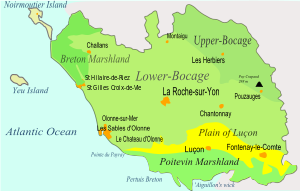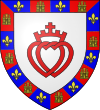Vendée
| Vendée | |||
|---|---|---|---|
| — Department — | |||
|
|||
 |
|||
| Coordinates: | |||
| Country | France | ||
| Region | Pays de la Loire | ||
| Prefecture | La Roche-sur-Yon | ||
| Subprefectures | Fontenay-le-Comte Les Sables-d'Olonne |
||
| Government | |||
| - President of the General Council | Philippe de Villiers | ||
| Area1 | |||
| - Total | 6,720 km2 (2,594.6 sq mi) | ||
| Population (2007) | |||
| - Total | 607,430 | ||
| - Rank | 38th | ||
| - Density | 90.4/km2 (234.1/sq mi) | ||
| Time zone | CET (UTC+1) | ||
| - Summer (DST) | CEST (UTC+2) | ||
| Department number | 85 | ||
| Arrondissements | 3 | ||
| Cantons | 31 | ||
| Communes | 282 | ||
| ^1 French Land Register data, which exclude estuaries, and lakes, ponds, and glaciers larger than 1 km2 | |||
The Vendée (French pronunciation: [vɑ̃ˈde]) is a department in the Pays-de-la-Loire region in west central France, on the Atlantic Ocean. The name Vendée is taken from the Vendée river which runs through the south-eastern part of the department.
Contents |
History

Windmill of Rairé
|
The area today called the Vendée was originally known as the Bas-Poitou and is part of the former province of Poitou. In the south-east corner, the village of Nieul-sur-l'Autise is believed to be the birthplace of Eleanor of Aquitaine (1122-1204) and was part of her kingdom. Eleanor's son, Richard I of England (the Lionheart) often had his base in Talmont. The Hundred Years' War (1337-1453) turned much of the Vendée into a battleground.
Since the Vendée held a considerable number of influential Protestants, including control by Jeanne d'Albret, the region was greatly affected by the French Wars of Religion which broke out in 1562 and continued until 1598. Eventually King Henri IV issued the Edict of Nantes and the Wars came to an end. The revocation of the Edict of Nantes in 1685 caused many Huguenots to flee from the Vendée.
It is also remembered as the place where the peasants revolted against the Revolutionary government in 1793. They resented the changes imposed on the Roman Catholic Church by the Civil Constitution of the Clergy (1790) and broke into open revolt in defiance of the Revolutionary government's military conscription. A guerrilla war, known as the Revolt in the Vendée, led at the outset by an underground faction called the Chouans (tawny owls), cost more than 100,000 lives before it ended in 1796.
In 1815, when Napoleon returned from Elba for his Hundred Days, La Vendée refused to recognise him and stayed loyal to King Louis XVIII. General Lamarque led 10,000 men into La Vendée to pacify the region.[1]
In 1850, British author Anthony Trollope published his book La Vendée, detailing the history of the region and the war. In the preface he pays tribute to Madame de la Rochejaquelein, on whose memoirs of the war he based his story.
The Revolt in the Vendée is the subject of Ninety-Three (Quatrevingt-treize), the last novel by the French writer Victor Hugo and also the backdrop of Les Chouans by Balzac.
In the writings of Karl Marx regarding revolutionary struggles in various countries, he uses the term "a Vendée" as meaning "a focus of persistent counter-revolutionary activities".
Geography & Climate


Vendée's highest point is Puy-Crapaud (295 m).
The department is crossed by four rivers: the Sèvre Nantaise (135 km), the Vendée (70 km), the Lay (110 km) and the Sèvre Niortaise (150 km).
Higher education
The main University of this department is the Catholic Institute of Higher Studies - ICES (Institut Catholique d'Études Supérieures - Official Website) in La Roche-sur-Yon. The main goal of this institute is to achieve academic excellence through an enhancement of the Christian and human dimension in seven areas of study. Founded in 1989, Catholic Institute of Higher Studies - ICES has pioneered a new concept in higher education, that of the “University School” : halfway between the French Grande École and the traditional state university.
Economy
The primary drivers of the Vendéen economy are:
- Tourism
- Agriculture
- Food Processing
- Light/Medium Industry.
The Vendée has been cited as the most economically dynamic department in France by L'Express magazine in a 2006 survey (L'Express 2006 Survey Results - in French). Its economy is characterised by a low rate of unemployment (around 7% in late 2006 compared to more than 9% nationally) and a very high proportion of small and medium sized businesses (one business for every 14 inhabitants).
Tourism
The coast of the Vendée extends over 200 km of mostly sandy beaches. Coupled with an exceptionally mild climate, these have long attracted large numbers of overseas and domestic tourists. Some popular resorts include Les Sables-d'Olonne, La Tranche-sur-Mer and Saint-Jean-de-Monts. Some beaches are "blue flagged" for cleanliness.
Inland, the chief attractions include the Marais Poitevin (an area of marshlands famed for wildlife), the forested area around the village of Mervent, the rolling countryside of the Bocage and the historical theme park at the Puy du Fou.
Agriculture
Agriculture remains a significant source of employment in the Vendée. The department has the second highest level of revenue from agriculture in France. The major arable crops grown are maize, colza (oil seed rape), wheat and sunflowers. Meat and dairy production also feature, as does the offshore farming of shellfish (oysters and mussels). Poultry from Challans is highly regarded nationwide as is lamb produced from the salt marshes in the North of the Vendée.
Demonstrating its support for the agricultural sector, the Conseil Général of the Vendée has a stated policy to promote the construction of irrigation reservoirs to reduce dependence on ground water during key summer growing seasons.
Food Processing & Manufacturing
The Vendée is home to a large number of food processing firms, including some nationally important firms. Fleury Michon (in French), a manufacturer of ready-meals and charcuterie employs the vast majority of its workforce (some 3000 people) at plants in the Vendée. Other important employers include bakeries and biscuit producers.
The department also has some speciality products, including a distinctive brioche (Label Rouge) and a raw cured ham (Jambon de Vendée) similar in flavour to bacon.
Wine is also produced in the area around the communes of Vix, Brem, Pissotte and Mareuil-sur-Lay, and is marketed under the "Fiefs Vendéens" designation. Production quality has improved markedly over recent years, and, having already achieved the classification Vin Délimité de Qualité Supérieure (VDQS), the wines are on their way towards A.O.C status (Appellation d’Origine Contrôlée). Wines of Mareuil
Industry
Much of the manufacturing industry in the Vendée reflects its status as a major tourist destination. Mobile homes are manufactured at plants in Luçon and the building of motor and sail yachts takes place at locations all over the department. The service sector too is strongly inclined towards tourism with campsites, restaurants and other tourism businesses being important sources of revenue and employment.
Demographics
Vendée's inhabitants are referred to as Vendeans (French Vendéens [vɑ̃deˈɑ̃]).
- Main towns:
- La Roche-sur-Yon [laʁɔʃsyʀjɔ̃]
- Challans [ʃɑlɑ̃]
- Les Herbiers [lezɛʁʙje]
- Les Sables-d'Olonne [lesɑbdolɔn]
- Fontenay-le-Comte [fɔ̃tnɛlkɔ̃t]
Culture
With more than 100 miles of sandy beaches edged with dunes and pine woods, and a very mild climate, Vendée is today a popular tourist destination. There is an extensive nude beach just south of La Faute sur Mer on the Pointe d'Arçay. The department also boasts many churches and abbeys, museums, and - for nature lovers - there are thousands of marked footpaths, a signposted bicycle route running along the coastal mudflats, and marshes that attract unusual birds. Fishing is popular in the ocean or in the Vendée's rivers and lakes.
Gastronomy
- Jambon-mogettes ( Ham and white beans) is the most famous Vendean dish.
- The department is the largest brioche producer in France, with the Brioche de Vendée made in the Bocage.
- In the Plain of Luçon, préfou is a garlic bread that can be served as an aperitif.
- In the marshland of the North-West, the poultry of Challans, especially duck, is well-known in the gastronomic world.
- The department has several small vineyards, around Brem, Mareuil, Vix, and Pissotte.
Politics

In the Vendée, 31 members, elected through universal suffrage, govern the affairs of the department, with 27 members on the right-wing and 4 members on the left-wing.
The Prefect represents the French State in the department.
The President of the General Council is the President of the Movement for France, Philippe de Villiers, who has held the office since 1988. He is seen as the department's political strongman.
| Party | seats | |
|---|---|---|
| • | Miscellaneous Right | 14 |
| • | Movement for France | 10 |
| Socialist Party | 4 | |
| • | Union for a Popular Movement | 2 |
| Miscellaneous Left | 1 | |
| • | New Centre | 1 |
See also
- Cantons of the Vendée department
- Communes of the Vendée department
- Arrondissements of the Vendée department
- Ninety-Three (a novel by Victor Hugo)
- Revolt in the Vendée (counter-revolt to the French Revolution)
- Puy du Fou (a historical theme park)
- Vendée Globe
- Julien Le Blant
References
- ↑ Encyclopædia Britannica Eleventh Edition Waterloo Campaign
External links
- (French) General council website
- (French) Prefecture website
- (French) Vendee Tourist Board
|
|||||
|
|||||
